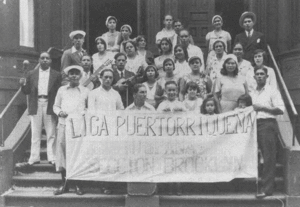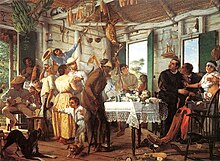
| Part of a series on |
| Race and ethnicity in New York City |
|---|
| Part of a series on |
| Puerto Ricans |
|---|
 |
| By region or country |
| Subgroups |
| Culture |
| Religion |
| History |
| Language |
|
|
The first Puerto Ricans known to have migrated to New York City did so in the mid-1800s when Spain ruled Puerto Rico. Another wave of Puerto Ricans migrated to New York City after the Spanish–American War in 1898.[1] Though no longer subjects of Spain, they were now citizens of an American possession and needed passports to travel to the contiguous United States.
That was until 1917, when the United States Congress approved Jones–Shafroth Act which gave Puerto Ricans in Puerto Rico U.S. citizenship with certain limitations. Puerto Ricans living in the mainland United States however, were given full American citizenship and were allowed to seek political office in the states in which they resided. Two months later, when Congress passed the Selective Service Act, conscription was extended to the Puerto Ricans both on the island and on the mainland. It was expected that Puerto Rican men 18 years and older serve in the U.S. military[2] during World War I.[1] The Jones–Shafroth Act also allowed Puerto Ricans to travel between Puerto Rico and the U.S. mainland without a passport. The advent of air travel was one of the principal factors that led to the largest wave of migration of Puerto Ricans to New York City in the 1950s, known as "The Great Migration."
In New York City and other northeast cities such as Philadelphia and Boston, Puerto Ricans were the first Hispanics to come in large numbers as early as the 1940s, being seen as the "Pioneer" group among the Hispanic community in these cities. From 1970 until about 1990, the city's Puerto Rican population was at its height. They represented up to 80% of the city's Hispanic community and 12% of the city's total population. At that time, nearly 70% of Puerto Ricans in the mainland United States lived in New York City. It wasn't until the 1990s that the percentage of Puerto Ricans that made up the city's Hispanic community and the population as a whole started to decrease, largely due to a declining Puerto Rican population, an increasingly diverse Hispanic community, and economic changes associated with New York's declining industrialism. The 2020 Census showed that New York's Puerto Rican population continued to decline over the preceding decade despite estimates that fostered contrary expectations.[3][4]
According to the 2010 Census, Puerto Ricans represented 8.9% of the population of New York City (32% of the city's Hispanic community) and 5.5% of that of New York State.[5] The Puerto Rican share of New York City decreased to 6.7% by 2020 as Puerto Ricans left the city and new arrivals from the island increasingly went to other destinations.[4][6] Of over a million Puerto Ricans in the state, about 70% live in New York City, with the remaining portion scattered in the city's suburbs and other major cities in New York State. Although Florida has received some dispersal of the population, the late 2000s and early 2010s saw a resurgence in Puerto Rican migration to New York and New Jersey, primarily for economic and cultural considerations,[7][8] topped by another surge of arrivals after Hurricane Maria devastated Puerto Rico in September 2017. Consequently, the New York City Metropolitan Area witnessed a significant increase in its Nuyorican population, New Yorkers of Puerto Rican descent, from 1,177,430 in 2010 to a Census-estimated 1,494,670 in 2016,[3] followed by a decline to 1,072,950 in 2022.[9] Despite these changes, New York remains the most important cultural and demographic center for Puerto Ricans outside San Juan.
- ^ a b "The World of 1898: The Spanish–American War". Loc.gov. June 22, 2011. Retrieved June 2, 2013.
- ^ "Puerto Rican Laborers During World War I". Historymatters.gmu.edu. Retrieved June 2, 2013.
- ^ a b "Selected Population Profile in the United States, 2016 American Community Survey 1-Year Estimates". United States Census Bureau. Archived from the original on February 14, 2020. Retrieved September 22, 2017.
- ^ a b Cite error: The named reference
:3was invoked but never defined (see the help page). - ^ Cite error: The named reference
ByType2010was invoked but never defined (see the help page). - ^ "Declining Puerto Rican Population in New York City: Study". CUNY Graduate Center. February 1, 2024. Retrieved October 2, 2024.
- ^ Cindy Y. Rodriguez (March 22, 2014). "Why more Puerto Ricans are living in mainland U.S. than in Puerto Rico". CNN. Retrieved March 22, 2014.
- ^ Dolores Prida (June 8, 2011). "The Puerto Ricans are coming!". New York Daily News. Retrieved March 22, 2014.
- ^ "Explore Census Data". data.census.gov. Retrieved October 3, 2024.
